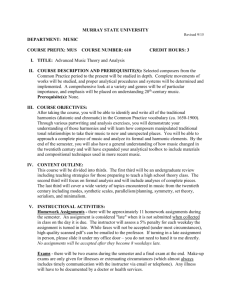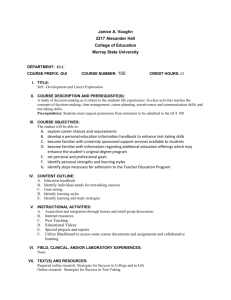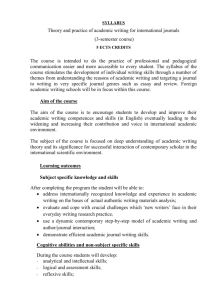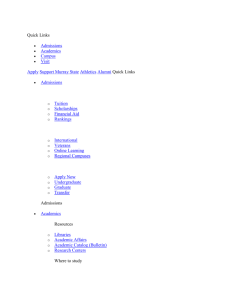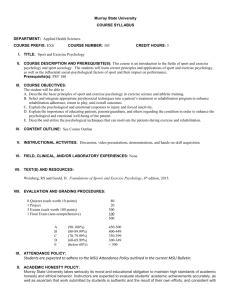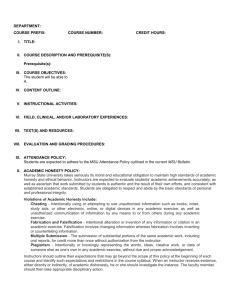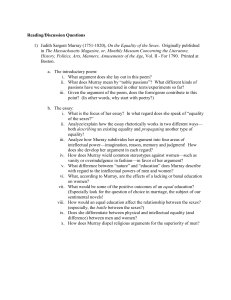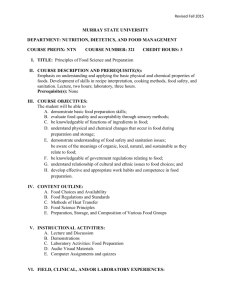Online Course Development and Review
advertisement
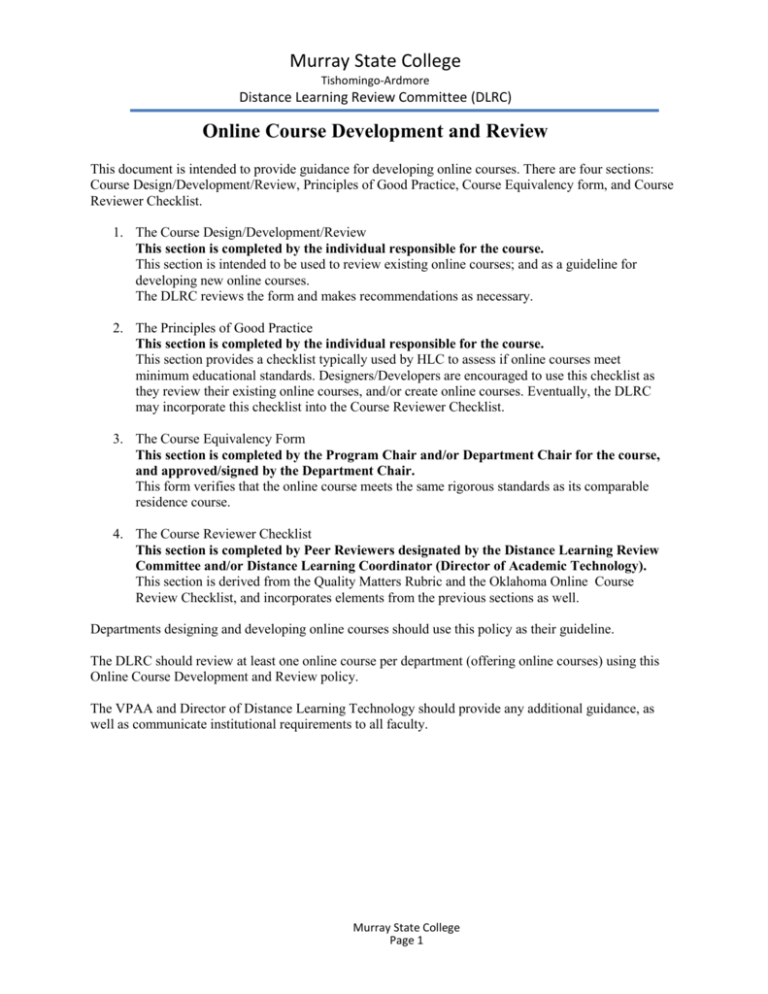
Murray State College Tishomingo-Ardmore Distance Learning Review Committee (DLRC) Online Course Development and Review This document is intended to provide guidance for developing online courses. There are four sections: Course Design/Development/Review, Principles of Good Practice, Course Equivalency form, and Course Reviewer Checklist. 1. The Course Design/Development/Review This section is completed by the individual responsible for the course. This section is intended to be used to review existing online courses; and as a guideline for developing new online courses. The DLRC reviews the form and makes recommendations as necessary. 2. The Principles of Good Practice This section is completed by the individual responsible for the course. This section provides a checklist typically used by HLC to assess if online courses meet minimum educational standards. Designers/Developers are encouraged to use this checklist as they review their existing online courses, and/or create online courses. Eventually, the DLRC may incorporate this checklist into the Course Reviewer Checklist. 3. The Course Equivalency Form This section is completed by the Program Chair and/or Department Chair for the course, and approved/signed by the Department Chair. This form verifies that the online course meets the same rigorous standards as its comparable residence course. 4. The Course Reviewer Checklist This section is completed by Peer Reviewers designated by the Distance Learning Review Committee and/or Distance Learning Coordinator (Director of Academic Technology). This section is derived from the Quality Matters Rubric and the Oklahoma Online Course Review Checklist, and incorporates elements from the previous sections as well. Departments designing and developing online courses should use this policy as their guideline. The DLRC should review at least one online course per department (offering online courses) using this Online Course Development and Review policy. The VPAA and Director of Distance Learning Technology should provide any additional guidance, as well as communicate institutional requirements to all faculty. Murray State College Page 1 Murray State College Tishomingo-Ardmore Distance Learning Review Committee (DLRC) Contents Online Course Development and Review ..................................................................................................... 1 SECTION 1 ..................................................................................................................................................... 3 Course Design/Development/Review ........................................................................................................... 3 Section 2 ........................................................................................................................................................ 6 Principles of Good Practice ........................................................................................................................... 6 Course Equivalency Form .............................................................................................................................. 9 Course Reviewer Checklist .......................................................................................................................... 10 Murray State College Page 2 Murray State College Tishomingo-Ardmore Distance Learning Review Committee (DLRC) SECTION 1 Course Design/Development/Review Completed by Instructor/Course Developer Reviewed by DLRC Instructor/Course Designer Information Name: Title: Phone Number: E-mail: Course Information Please be sure that information is accurate and complete. Course Title: Course ID: Section Number(s): Semester: Year: Recommended Enrollment Limit: Prerequisite (s) and/or required academic skills/background of students: Course Description: Course Location & Access Information (select all that apply) Please do not give out the course designer’s username or id. Either shared access or a guest account will be provided by the Director of Academic Technology. Please note that publisher resources may require an additional access code for student access. MSC Blackboard (required) Publisher Website Other – Instructor/Course Developer will be contacted for details. Please list website below. Website: Type of Distance Learning Delivery (select all that apply) No campus or proctored exams Some proctored exams required Proctored exams required On-campus meeting required Murray State College Page 3 Murray State College Tishomingo-Ardmore Distance Learning Review Committee (DLRC) General Course Design Description Describe any training and/or experience you have had in preparation for this mode of Distance Learning course delivery. If you are using pre-developed courseware or other online or video content from a publisher or faculty member, please describe. Describe from your syllabus the methods of student testing/assessment you plan to utilize in the course, and your reasons for choosing those methods. Describe how academic integrity will be ensured with regard to online tests and quizzes. Explain why you believe the chosen mode of Distance Learning delivery (on page 1) is appropriate for this course. Please use this area to include any other comments you would like to add regarding your course. Murray State College Page 4 Murray State College Tishomingo-Ardmore Distance Learning Review Committee (DLRC) Americans with Disabilities Act It is important that all online courses meet the guidelines of the Americans with Disability Act and specifically the Rehabilitation Act Amendments of Section 508. For information about the actual guidelines, please consult the College ADA Compliance Officer. Yes No College ADA statement is in course shell and/or syllabus. Will this online course be able to reasonably accommodate documented ADA requirements should they be necessary to meet the needs of the student? Instructor has received training/guidance in providing reasonable accommodations for students. Instructor would like to receive training in providing reasonable accommodations to students. Course Copyright and Permissions The instructor and his/her colleagues must ensure all copyright provisions are met. In any case where the institution and/or course author (s) warrant that they are the only owner (s) contributing copyrightable expression, the institution and/or course author (s) warrant that they are the only owner (s) of the course and have full power and authority to make this agreement; and that the course does not infringe upon any copyright, violate any property rights, or contain any scandalous, libelous or unlawful matter. Names (s) of copyright holders: Yes No In Progress Have you confirmed that the course materials and any course materials not developed by the copyright holder are “fair use” or that you are otherwise exempt from liability from infringement? If not, have you acquired permission to use or link to the materials? Additional Information/Comments as appropriate: Murray State College Page 5 Murray State College Tishomingo-Ardmore Distance Learning Review Committee (DLRC) Section 2 Principles of Good Practice From the HLC with some revision: According to the Higher Learning Commission, all learning-focused organizations should strive to create learning environments supportive of the multiple learning styles of their students, and frequently turn to new technologies to assist in these efforts. The HLC criterion of accreditation draws particular attention not only to the need to attend to learning environments, but also the need to attend to services and facilities that support student learning. The institution’s program quality and learning goals should be consistent across all modes of delivery and all locations (on the main campus, at additional locations, by distance delivery, as dual credit, through contractual or consortial arrangements, etc.). The learning-focused organization also supports the learning of other key constituents. Principles of Good Practice for Distance Education (APA) 1. That education is best experienced within a community of learning where competent professionals are actively and cooperatively involved with creating, providing, and improving the instructional program; 3. That learning is dynamic and interactive regardless of the setting in which it occurs; 4. That instructional programs leading to degrees have integrity and are organized around substantive and coherent curricula which define expected learning outcomes; 5. That institutions accept the obligation to address student needs related to, and to provide the resources necessary for their academic success; 6. That institutions are responsible for the education provided in their name; 7. That institutions undertake the assessment and improvement of their quality, giving particular emphasis to student learning; and, 8. That institutions voluntarily subject themselves to peer review. Source: (2002) PRINCIPLES OF GOOD PRACTICE IN DISTANCE EDUCATION AND THEIR APPLICATION TO PROFESSIONAL EDUCATION AND TRAINING IN PSYCHOLOGY, Report of the Task Force on Distance Education and Training in Professional Psychology, American Psychological Association Principles of Good Practice: Curriculum and Instruction 1. The course offered electronically is coherent and complete. Yes No Necessary course materials are identified. Information on how to purchase or obtain materials is provided if necessary. If students are not required to meet on campus, they can complete the course without physically visiting the institution offering the course. (i.e. all necessary instruction and support infrastructure is in place to serve the off-campus students.) Murray State College Page 6 Murray State College Tishomingo-Ardmore Distance Learning Review Committee (DLRC) 2. The course includes: Note: A positive response is required for the following unless otherwise indicated. Most of these items will be present in the MSC Online Syllabus Template provided by the Academic Affairs office. Yes No Introduction (i.e. “Start here” button) Instructor introduction Course prerequisites Course number & title Instructor name/contact information Required text including ISBN Contact information for the MSC Bookstore Learning objectives Information on course assessment and grading policy Information and/or links to learner support services Policies and Procedures of the course Calendar of all assignments Graphical and multimedia elements (optional) PDF and other downloadable files (optional) Links to other web sites (optional) Interactive exercises (optional) Evaluation instruments (i.e. Turnitin.com, Connect) (optional) Link to online conference or chat (optional) 3. Technical Requirements: Yes No Support information or link Technical requirements for the course Updated internet browser plug-ins (Adobe Flash player, Adobe Shockwave, etc.) Technical requirements specific to course: Microsoft Word Microsoft Excel Microsoft PowerPoint Adobe Acrobat Other - Specify below: Murray State College Page 7 Murray State College Tishomingo-Ardmore Distance Learning Review Committee (DLRC) 4. The course provides for multiple avenues for interaction between faculty and students and among students (minimum of 3 avenues of interaction). Yes No Interaction with and among students is achieved through (check all that apply): Asynchronous discussion Synchronous chat Team projects Individual email Group email Audio conference Telephone Interactive Video (ITV) Student posting of assignments for review by other students Other - Specify below: Feedback for students is provided in a timely manner. Assignments are assessed within 10 working days and questions are answered within 2 working days. Guidelines for feedback are defined or outlined in the syllabus or course menu. Opportunities for student-faculty and student-student interaction allow for the development of an online learning community that is independent of course assessment (i.e. Open discussions, virtual café, chat room, etc.) 5. Academic standards for all programs or courses offered electronically will be the same as those for programs or courses delivered by other means at the institution where the program or course originates. Yes No The online course provides students with goals and objectives that are equivalent to goals and objectives used the lecture course. The online course specifies technology, competence and skills that are equivalent to the lecture course This online course meets the same institutional standards for content, reflective learning, competencies, etc. as the lecture course. The online course has assessment and evaluation practices equivalent to the lecture course. This online course demonstrates equivalent rigor and expectation to the lecture course. Murray State College Page 8 Murray State College Tishomingo-Ardmore Distance Learning Review Committee (DLRC) Course Equivalency Form Completed by Department/Program Chair Course Developer: Course ID & Title: This form is used as documentation for the following: The appropriate department chair certifies that the course’s learning outcomes are appropriate in rigor, depth, and breadth with the degree or certificate awarded and that this course meets the same academic standards as the same course offered by other means. Appropriate Learning Outcomes (Place an “X” next to the item.) The course’s learning outcomes as contained in the course syllabus are appropriate in rigor, depth, and breadth with the degree or certificate awarded. The course meets the same academic standards as the same course offered by other means. (Place an “X” next to each item.) Textbook and additional materials are comparable to the same course offered by other means. Course assessments are comparable to the same course offered by other means. Any other course activities are comparable to the same course offered by other means. Department Chair Approval If the instructor of the course is also the Department Chair, the appropriate Vice President must also sign this form. Signature: Printed Name: Date: Murray State College Page 9 Murray State College Tishomingo-Ardmore Distance Learning Review Committee (DLRC) Course Reviewer Checklist Completed by DLRC Course ID: Title: Semester: Reviewer Names: Initial Review Date: Follow-up Review Date (if required): Approved for delivery, no recommendation Approved for delivery, with recommendation Needs further development Approved for delivery, no recommendations Approved for delivery, with recommendations Standard 1: Course Overview & Introduction The overall course design is made clear to student at the beginning of the course. The course introduction sets the tone for the course, lets students know what to expect, and provides guidance to ensure they get off to a good start. 1. Instructions make it clear how to get started and where to find various course components (i.e. Start button). 2. Students are introduced to purpose & structure of the course (meeting times, pace, etc.). 3. Etiquette (netiquette) expectations for online discussions, email, & other forms of communication are clearly stated. 4. Course and institutional policies with which the student is expected to comply are clearly stated, or a link to current policies is provided (late work, plagiarism, make-up tests, etc.) 5. Prerequisite knowledge in the discipline and/or any required competencies are clearly stated. 6. Minimum technical skills expected of the student are clearly stated. 7. A self-introduction by the instructor is available (bio/instructor info page, discussion intro, etc.). 8. Students are asked to introduce themselves to the class. Standard 2: Learning Objectives Learning objectives are measurable and are clearly stated. Learning Objectives establish a foundation upon which the rest of the course is based. 1. The Course learning objectives describe outcomes that are measurable. 2. The module/unit learning objectives describe outcomes that are measurable and consistent with course-level learning objectives. 3. Learning objectives are stated clearly and written from the student’s perspective. X N/A COMMENTS/FEEDBACK X N/A COMMENTS/FEEDBACK Murray State College Page 10 Murray State College Tishomingo-Ardmore Distance Learning Review Committee (DLRC) 4. Instructions to students on how to meet the learning objectives are adequate & clearly stated. 5. Learning objectives are appropriately designed for the level of the course. 6. Course learning outcomes, content, and coverage is equivalent to that in on-campus sections. Standard 3: Assessment & Measurement Assessment strategies are designed to evaluate student progress of stated learning objectives; to measure the effectiveness of student learning; integral to learning process. 1. The types of assessments selected measure the stated learning objectives & are consistent with the course activities and resources. 2. The course grading policy is clearly stated. 3. Specific & descriptive criteria are provided for the evaluation of students’ work; tied to the course grading policy. 4. The assessment instruments selected are sequenced, varied; allowing student to build mastery. 5. Students have multiple opportunities to measure their own learning progress. 6. The assignment due dates and test dates are clearly stated. X 7. The instructor has made appropriate provisions with the Testing and Assessment Center for scheduling, and has given students sufficient notice about testing dates/location. 8. Assignments/ projects/tests are comparable and/or equivalent to those in on-campus sections. (Course Equivalency Form) 9. Student progress is assessed a minimum of once every week in addition to exams and other major evaluations (i.e. quizzes, discussions, attendance, Connect assignments, etc). 10. Student’s assessment is documented in the Blackboard grade book. Murray State College Page 11 N/A COMMENTS/FEEDBACK Murray State College Tishomingo-Ardmore Distance Learning Review Committee (DLRC) Standard 4: Instructional Materials Instructional materials are sufficiently comprehensive to achieve stated course objectives and learning outcomes. 1. The instructional materials contribute to the achievement of the stated course/unit objectives. 2. The purpose of the instructional materials and how they are to be used for learning is clear. 3. All resources and materials used in the course are appropriately cited. 4. The instructional materials are current. 5. The instructional materials present a variety of perspectives in the course content. 6. The distinction between required and optional material is clearly explained. 7. The textbook as well as other learning materials for the course are the same as, or comparable to that used in oncampus sections. (Course Equivalency Form) Standard 5: Learner Interaction & Engagement Forms of interaction incorporated in the course motivate students and promote learning. This standard includes student-instructor, student-content, and student-student interactions. Courses should integrate multiple forms of interaction. 1. Learning activities promote the achievement of the stated course/unit learning objectives. 2. Learning activities provide opportunities for interaction that support active learning. 3. Instructor has provided a plan for classroom response time, including feedback on assignments. 4. The requirements for student interaction are clearly articulated. Standard 6: Course Technology Course navigation & technology support student engagement and ensure access to course components. 1. The tools and media support the course/unit learning objectives. 2. Course tools and media support student engagement and active learning. 3. Navigation throughout the online components is logical, consistent, and efficient. 4. Students can readily access the technologies required in the course (consider varying internet speeds, costs, hardware needs, etc.) 5. The course technologies are current. X N/A COMMENTS/FEEDBACK X N/A COMMENTS/FEEDBACK X N/A COMMENTS/FEEDBACK Murray State College Page 12 Murray State College Tishomingo-Ardmore Distance Learning Review Committee (DLRC) Standard 7: Learner Support The course facilitates student access to institutional support services essential to student success. 1. The course provides instructions or links to technical support offered, and how to access services. 2. Course instructions articulate or link to institutions accessibility policies & services. 3. Course instructions articulate or link to institutions academic support services & other resources that can help the students succeed, and how to access the services. 4. Course instructions articulate or link to student support services and how to access the resources. Standard 8: Accessibility The course demonstrates a commitment to accessibility for all students. 1. The course employs accessible technologies and provides guidance on how to obtain accommodation. 2. The course contains equivalent alternative to auditory and visual content. 3. The course design facilitates readability and minimizes distractions. 4. The course design accommodates the use of assistive technologies. X N/A COMMENTS/FEEDBACK X N/A COMMENTS/FEEDBACK Additional Oklahoma Online Quality Assurances: APPROPRIATE SECURITY MEASURES ARE X N/A COMMENTS/FEEDBACK INCLUDED TO ENSURE ACADEMIC INTEGRITY Assessments are used throughout the course (e.g. not just at the end). A variety of assignments and assessment methods are used to increase rigor, and provide instructor multiple ways to assess student performance consistency (e.g. not just exams). Which of the following strategies/tools are used to ensure academic integrity (select all that apply): Exams are password protected Questions on exams are seen 1 or few per page Plagiarism software used on written exams, assignments, projects, etc. Date restrictions are placed on exams Time limits are placed on exams Lockdown browser tool is used Exams are composed of random questions from a larger pool to ensure student have equivalent but different online tests Murray State College Page 13 Murray State College Tishomingo-Ardmore Distance Learning Review Committee (DLRC) APPROPRIATE INTERACTION TOOLS ARE INCLUDED TO ENSURE INSTRUCTOR ONLINE X N/A COMMENTS/FEEDBACK PRESENCE Contacts is initiated with students in a variety of ways (select all that apply): Announcements Discussion Board participation Email Participation in online group collaboration projects Face-to-face meetings (review sessions, scheduled meetings, etc.) Chat sessions or virtual meetings Voice enabled messages Phone/Live Internet Conversations ADDITIONAL COMMENTS/FEEDBACK Murray State College Page 14 Murray State College Tishomingo-Ardmore Distance Learning Review Committee (DLRC) Course Reviewer Signature Page Completed by DLRC This instructor has received adequately training and/or has experience in the delivery of Distance Learning: No Yes This Course is a Quality Matters certified course: No Yes If Yes, provide certification year: This course is quality certified through an institutional review process: No Yes If Yes, provide date: This document serves as institutional verification hat the reviewed course complies with the above standards as indicated. I verify that the information provided on the checklists is, to the best of my knowledge, accurate and complete. Date: Instructor or Course Developer Date: Department Chair Date: Vice President of Academic Affairs Murray State College Page 15
